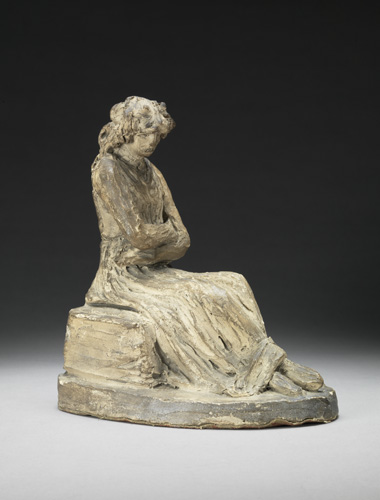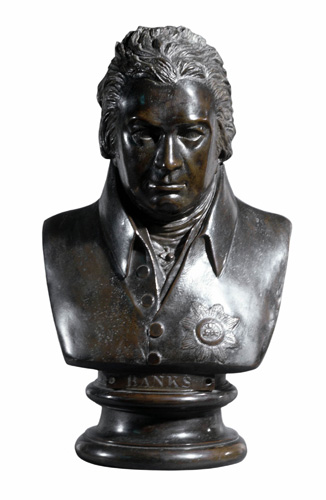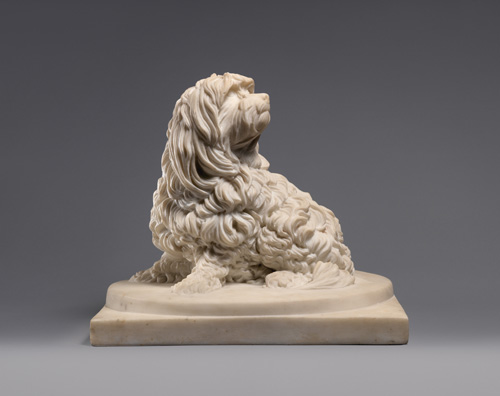Anne Seymour Damer
Active in: England
Biography
The English sculptor Anne Seymour Damer was born in Berkshire in 1748. Damer spent her youth in the care of her cousin Horace Walpole, who praised her work as an artist. She inherited the Strawberry Hill House from Walpole in 1797. In 1767, she married John Damer, son of Lord Milton, later the 1st Earl of Dorchester. She began making sculptures after his death in 1776. Between 1785 and 1811, Damer was an honorary exhibitor at the Royal Academy in London. Among her best-known works are the heads of the river gods Isis and Thame for the Henley bridge at Henley-on-Thames, Oxon. She was widely praised by her contemporaries for her naturalistic animal sculptures. Damer died in London in 1828.
Selected Works

Anne Seymour Damer, A Seated Woman, ca. 1780. Terracotta, 23.8 x 16.5 x 21.6 cm. Yale Center for British Art
Circle
Daughter of
Field Marshal Henry Seymour
Cousin of
Horace Walpole
Bibliography
Benforado, S. “Anne Seymour Damer (1748–1828), Sculptor.” PhD Dissertation, University of New Mexico, 1986.
Bilbey, Diane, with Marjorie Trusted. British Sculpture 1470 to 2000. A Concise Catalogue of the Collection at the Victoria and Albert Museum. London: V&A Publications, 2002.
Chapman, Caroline. Eighteenth-century Women Artists: Their Trials, Tribulations, and Triumphs. London: Unicorn, 2017.
Cunningham, A. The Lives of the Most Eminent British Painters, Sculptors and Architects. London, 1829–33.
Dallaway, J. Anecdotes of the Arts in England. London, 1800.
“DAMER, Anne Seymour.” The New Biographical Dictionary of Scottish Women. Edinburgh: Edinburgh University Press, 2018.
Escot, Angela. “A Female Sculptor and Connoisseur: Artistic Self-Fashioning and the Exposure of Connoisseurship, Collecting, and Concupiscence.” In Women and Material Culture, 1660–1830. Edited by Jennie Batchelor and Cora Kaplan, 103–15. New York: Palgrave MacMillan, 2007.
Eustace, Katharine. “Damer, Anne Seymour.” Oxford Art Online. https://doi-org.proxyiub.uits.iu.edu/10.1093/gao/9781884446054.article.T021255.
Fine, Elsa Honig. Women & Art: A History of Women Painters and Sculptors from the Renaissance to the 20th Century. London: Allanheld & Schram, 1978.
Gross, Jonathan David. The Life of Anne Damer: Portrait of a Regency Artist. Lanham: Lexington Books, 2014.
Gunnis, R. Dictionary of British Sculptors 1660–1851. London, 1951.
Heller, Nancy G. Women Artists: An Illustrated History. New York and London: Abbeville, 2003.
McClintock, John. “‘My colossus, my overgrown child’: Anne Seymour Damer’s Statue of George III in Edinburgh.” Burlington Magazine 152 (2010): 18–28.
Noble, Percy. Anne Seymour Damer: A Woman of Art and Fashion, 1748–1828. London: Trench & Trübner, 1908.
Puga, R. M. “Anne Seymour Damer’s Travel to Lisbon (1790–1791) and the Representation of Portugal Picturesque […]” Journal of Anglo-Portuguese Studies 27 (2018): 129–62.
Sterckx, Marjan. “Pride and Prejudice: Eighteenth-century Women Sculptors and Their Material Practices.” In Women and Material Culture, 1660–1830. Edited by Jennie Batchelor and Cora Kaplan, 86–102. New York: Palgrave Macmillan, 2007.
The Treasure Houses of Britain: Five Hundred Years of Private Patronage and Art Collecting. Washington: National Gallery of Art, 1985.
Walpole, Horace. Anecdotes of Painting in England. London: H. G. Bohn, 1849.
Wheatley, Henry Benjamin. London, Past and Present. London: Murray, 1881.
Whinney, Margaret. Sculpture in Britain, 1530–1830. New Haven: Yale University Press, 1992.
Yarrington, Alison. “Damer [née Conway], Anne Seymour.” Oxford Dictionary of National Biography. https://doi-org.proxyiub.uits.iu.edu/10.1093/ref:odnb/7084.
Yarrington, Alison. The Female Pygmalion: Anne Seymour Damer, Allan Cunningham and the Writing of a Woman Sculptor’s Life. London: Public Monuments and Sculpture Association, 1997.


